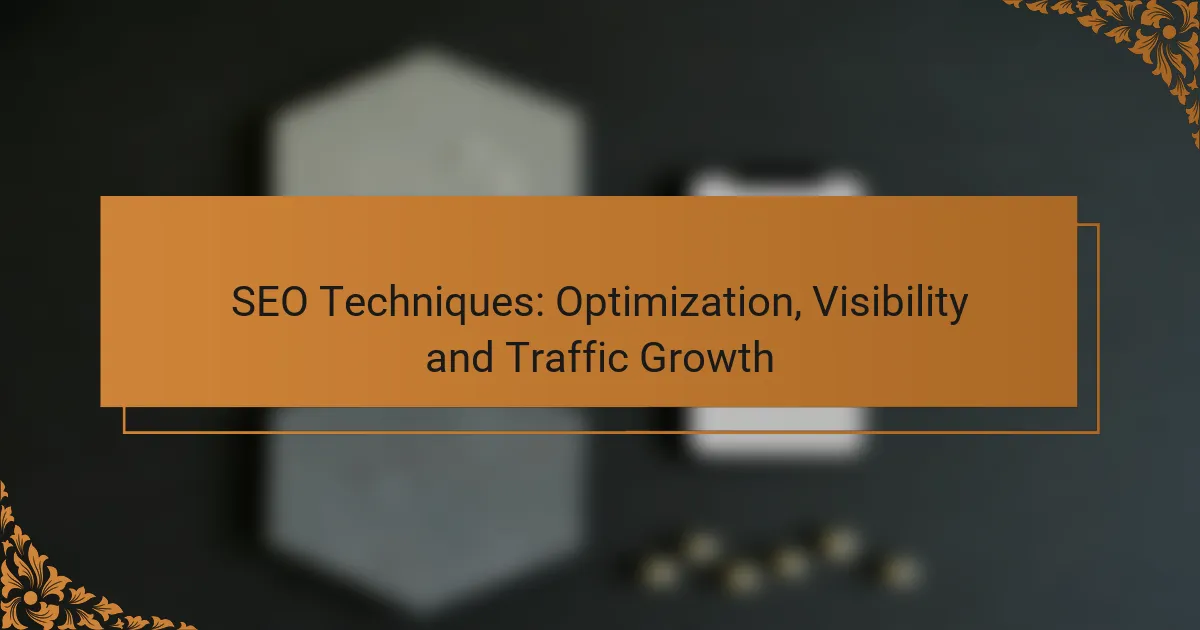SEO techniques are essential for enhancing your website’s visibility and driving organic traffic. By implementing strategies such as on-page optimization, technical SEO, and content marketing, you can improve your search engine rankings and attract more visitors. Monitoring key metrics like organic traffic and conversion rates will help you assess the effectiveness of your efforts and make informed adjustments for continued growth.

What are effective SEO techniques for visibility in the UK?
Effective SEO techniques for visibility in the UK focus on optimizing your website to rank higher in search engine results, thereby attracting more organic traffic. Key strategies include on-page optimization, off-page tactics, technical SEO, and integrating content marketing.
On-page optimization strategies
On-page optimization involves enhancing individual web pages to improve their search rankings. This includes optimizing title tags, meta descriptions, headers, and ensuring keyword relevance throughout the content. Aim for a keyword density of around 1-2% to avoid keyword stuffing while still being relevant.
Additionally, ensure your content is high-quality and provides value to users. Use engaging visuals and internal linking to guide visitors through your site, which can improve user experience and reduce bounce rates.
Off-page optimization tactics
Off-page optimization focuses on increasing your website’s authority through external factors. This primarily involves building backlinks from reputable sites, which can significantly enhance your site’s credibility. Aim for a diverse backlink profile by guest posting, collaborating with influencers, or participating in industry forums.
Social media engagement also plays a crucial role in off-page SEO. Sharing your content across platforms can drive traffic and create opportunities for backlinks, enhancing your visibility in search results.
Technical SEO best practices
Technical SEO ensures that your website meets the technical requirements of search engines. Key practices include optimizing site speed, ensuring mobile-friendliness, and implementing structured data markup. A fast-loading site (ideally under 3 seconds) improves user experience and can positively impact rankings.
Regularly check for crawl errors and broken links using tools like Google Search Console. Ensuring your website is secure (using HTTPS) is also essential for maintaining user trust and search engine favorability.
Content marketing integration
Integrating content marketing with SEO is vital for driving organic traffic. Create valuable, informative content that addresses the needs and interests of your target audience. This can include blog posts, videos, infographics, and podcasts that are optimized for relevant keywords.
Regularly update your content to keep it fresh and relevant, which can improve your rankings. Consider using a content calendar to plan and schedule your posts, ensuring consistent output and engagement with your audience.

How can SEO techniques drive traffic growth?
SEO techniques can significantly enhance website traffic by improving visibility in search engine results. By optimizing content, utilizing keyword strategies, and building quality backlinks, websites can attract more visitors and increase engagement.
Keyword research tools
Keyword research tools help identify the terms and phrases that potential visitors are searching for. Tools like Google Keyword Planner, SEMrush, and Ahrefs can provide insights into search volume, competition, and related keywords.
When using these tools, focus on long-tail keywords, as they often have lower competition and higher conversion rates. Aim for keywords that align closely with your content and audience intent.
Content optimization methods
Content optimization involves enhancing your website’s content to improve its relevance and readability for both users and search engines. This includes using targeted keywords naturally within headings, subheadings, and body text.
Additionally, ensure your content is structured with clear headings and includes multimedia elements like images and videos to enhance user engagement. Regularly updating content can also signal to search engines that your site is active and relevant.
Link-building strategies
Link-building strategies focus on acquiring backlinks from reputable websites to improve domain authority and search rankings. Techniques include guest blogging, creating shareable infographics, and engaging in partnerships with other businesses.
Quality is more important than quantity; aim for links from sites that have high domain authority. Avoid black-hat tactics like buying links, as these can lead to penalties from search engines.

What are the key metrics for measuring SEO success?
Key metrics for measuring SEO success include organic traffic, conversion rates, and search engine ranking positions. These metrics provide insights into how well your website is performing in search results and its effectiveness in attracting and converting visitors.
Organic traffic analysis
Organic traffic analysis focuses on the number of visitors arriving at your site through unpaid search results. Monitoring this metric helps you understand the effectiveness of your SEO strategies and the overall visibility of your website.
To analyze organic traffic, use tools like Google Analytics to track the number of sessions, unique visitors, and page views. A healthy growth trend typically indicates successful optimization efforts, while sudden drops may signal issues that need addressing.
Conversion rate tracking
Conversion rate tracking measures the percentage of visitors who complete a desired action, such as making a purchase or signing up for a newsletter. This metric is crucial because high traffic without conversions may indicate problems with your site’s user experience or content relevance.
To improve conversion rates, consider A/B testing different landing pages, optimizing call-to-action buttons, and ensuring your site loads quickly. Aim for a conversion rate that aligns with industry standards, which can vary widely but often falls between 1-5% for e-commerce sites.
Search engine ranking positions
Search engine ranking positions refer to where your website appears in search engine results pages (SERPs) for targeted keywords. Higher rankings typically lead to increased visibility and traffic, making this metric essential for assessing SEO effectiveness.
Regularly monitor your rankings using tools like SEMrush or Ahrefs to identify keyword performance. Focus on improving rankings for keywords that drive the most relevant traffic, and be aware that maintaining top positions requires ongoing optimization and content updates.

What prerequisites are needed for effective SEO?
Effective SEO requires a solid understanding of your website’s current performance, target audience, and competitive landscape. Key prerequisites include a well-structured website, quality content, and the right tools for analysis and optimization.
Website audit essentials
A website audit is a comprehensive evaluation of your site’s performance and SEO effectiveness. It should assess factors such as site speed, mobile-friendliness, on-page SEO elements, and overall user experience.
Key components of a website audit include checking for broken links, analyzing page load times, and ensuring proper use of meta tags. Tools like Google Search Console and SEMrush can facilitate this process, providing insights into areas needing improvement.
Competitor analysis frameworks
Competitor analysis involves examining your rivals’ SEO strategies to identify strengths and weaknesses. This can help you uncover opportunities for improvement and differentiation in your own approach.
Frameworks for competitor analysis typically include keyword gap analysis, backlink profiling, and content strategy evaluation. Tools like Ahrefs and Moz can assist in gathering data on competitors’ rankings, traffic sources, and content performance.

What are common SEO mistakes to avoid?
Common SEO mistakes can significantly hinder website visibility and traffic growth. Avoiding these pitfalls is crucial for effective optimization and achieving better search engine rankings.
Ignoring mobile optimization
Failing to optimize for mobile devices can lead to a poor user experience and lower search rankings. With a significant portion of web traffic coming from mobile users, it’s essential to ensure your site is responsive and loads quickly on smartphones and tablets.
To optimize for mobile, use responsive design techniques, compress images, and minimize the use of heavy scripts. Regularly test your site on various devices to ensure compatibility and functionality.
Neglecting local SEO strategies
Neglecting local SEO can result in missed opportunities for businesses that serve specific geographic areas. Local SEO helps improve visibility in local search results, making it easier for nearby customers to find your services.
To enhance local SEO, claim and optimize your Google My Business listing, gather customer reviews, and use local keywords in your content. Additionally, ensure your name, address, and phone number (NAP) are consistent across all online platforms.

How does user experience impact SEO?
User experience (UX) significantly influences SEO by affecting how visitors interact with a website. A positive UX leads to longer visits and lower bounce rates, which search engines interpret as indicators of quality, ultimately boosting a site’s visibility in search results.
Page load speed importance
Page load speed is crucial for user experience and directly affects SEO rankings. Websites that load within two to three seconds tend to retain more visitors, while slower sites can see increased bounce rates. Tools like Google PageSpeed Insights can help assess and improve load times.
To enhance page speed, consider optimizing images, leveraging browser caching, and minimizing HTTP requests. Aim for a total page size under 1 MB and keep the number of server requests low to ensure faster loading times.
Mobile responsiveness factors
Mobile responsiveness is essential as more users access websites via smartphones. A responsive design adapts to various screen sizes, providing a seamless experience that search engines favor. Google prioritizes mobile-friendly sites in its rankings, especially with the mobile-first indexing approach.
To ensure mobile responsiveness, use flexible layouts, scalable images, and CSS media queries. Regularly test your site on different devices and screen sizes to identify and fix any usability issues that may arise.
